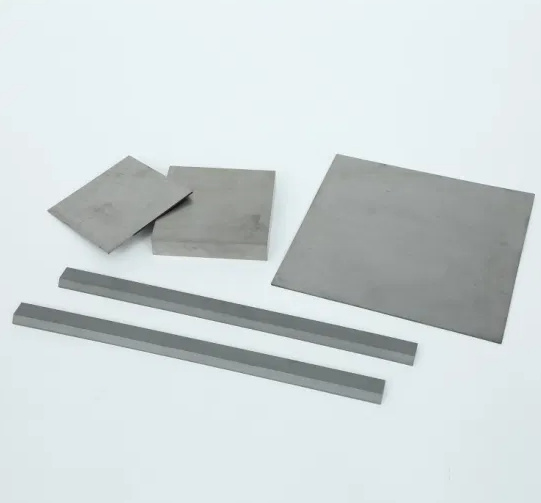概要
カーバイド プレートは精密機械加工と製造の世界の要であり、比類のない硬度、耐摩耗性、耐久性で知られている。しかし、超硬プレートの製造工程は、他の超硬部品とどのように異なるのでしょうか?このブログでは、この重要な工具の製造に関わるユニークな工程を紹介し、その決定的な違いを浮き彫りにする魅力的な旅にご案内します。
詳細紹介
超硬プレートとは?
超硬プレートは、非常に硬く、耐摩耗性に優れた複合材料として知られる炭化タングステンから作られた平らな長方形の部品です。これらのプレートは、切削工具、金型、摩耗部品など、精度と耐久性が最優先されるさまざまな用途で使用される。

その他の超硬部品
その他の超硬部品には、ドリル、エンドミル、インサート、摩耗部品などがあり、それぞれさまざまな産業で異なる用途に使用されています。これらの部品はすべてタングステンカーバイドの基本的な材料特性を共有していますが、形状、サイズ、特定の機能要件により、製造工程が大きく異なる場合があります。
超硬プレートの製造工程
超硬プレートの製造工程にはいくつかの重要なステップがあり、それぞれが最高の品質と性能を保証するために綿密に設計されています。これらの工程を詳しく調べ、他の超硬部品に使用される工程との違いを見てみましょう。
パウダーの準備
- 原材料の選択:プロセスは、高純度の炭化タングステン粉末とバインダー(通常はコバルト)を選択することから始まります。
- ミキシング:炭化タングステン粉末をコバルトバインダーと混合し、均一な混合物を作ります。この混合物は、プレートの均一な硬度と強度を確保するために重要です。
プレス
- プレートの成形:混合物を高圧プレス機で平らな長方形にプレスする。この工程が、超硬プレートと他の部品との最初の大きな違いとなる。ドリルやチップのような複雑な形状とは異なり、プレートは均一な厚みと平坦性が要求されるため、特殊なプレス技術が必要になります。
- グリーン・マシニング:プレス後、まだ "グリーン"(未焼結)状態のプレートは、正確な寸法と表面仕上げを達成するためにグリーン加工を受けることができる。
焼結
- 高温焼結:プレスされたプレートは、1400℃を超える炉で焼結される。この工程で炭化タングステン粒子が結合し、緻密で硬い材料が作られます。プレートの焼結工程は、反りを防止し、均一な密度を確保するために慎重に制御され、サポートや異なる温度プロファイルを必要とするかもしれないより複雑な形状の焼結とは異なります。
- 冷却:焼結後、プレートはクラックや歪みの原因となる熱応力を避けるため、室温までゆっくりと冷却される。
仕上げ
- 研削と研磨:焼結されたプレートは、研削と研磨を経て、所望の表面仕上げと正確な寸法を達成する。この工程は、平坦性と平滑性が重要な基準面や摩耗部品として使用されることが多いプレートにとって非常に重要です。
- 検査:各プレートは、欠陥、寸法精度、表面仕上げが検査されます。厳格な品質管理により、厳しい基準を満たしたプレートだけが最終的な梱包へと進みます。
仕上げのテクニック
超硬プレートの仕上げ技術は特に厳しい。精密工具や摩耗プレートとして使用されるため、高度な平坦度と表面仕上げを達成することが最も重要です。そのため、ダイヤモンド砥粒を使用し、研削とラッピングを何段階にも分けて行い、所望の公差を達成することがよくあります。
コーティング(オプション)
一部の超硬プレートには、窒化チタンやダイヤモンドライクカーボンなどのコーティングが施されています。これらのコーティングは耐摩耗性を高め、摩擦を低減し、プレートの寿命をさらに延ばす。コーティング・プロセスには、物理的気相成長法(PVD)や化学的気相成長法(CVD)が使われるが、均一な被覆を達成するのが難しいため、複雑な形状の部品にはあまり適用されていない。
他の超硬部品との比較
製造工程の違い
| プロセスステップ | 超硬プレート | その他の超硬部品 |
|---|---|---|
| プレス | 平面形状の高圧プレス | 多様な形状に対応する複雑な金型 |
| グリーン・マシニング | 平坦度のための精密機械加工 | 部品の形状により異なる |
| 焼結 | 反りを防止する制御 | 複雑な形状にはサポートが必要な場合がある |
| 仕上げ | 多段階の研削とラッピング | 重要度の低い部品ほどシンプルであることが多い。 |
| コーティング | 多くの場合、性能向上のためにコーティングされている | 一般的ではなく、均一にコーティングするのがより複雑 |
その他超硬部品製造
ドリルやチップなどの他の超硬部品の製造工程は、超硬プレートと似ている部分もあるが、大きな違いもある:
- 複雑なプレス:プレートの均一なプレスとは異なり、他の部品は複雑な形状を実現するために複雑な金型を必要とする。
- 特殊焼結:複雑な形状の焼結工程では、変形を防ぐための特別なサポートが必要になることがある。
- 工具研削:切削工具の場合、刃先とフルートを形成するために追加の研削工程が必要だが、これは板材には不要な工程である。
- コーティングの課題:複雑な形状を均一にコーティングすることは、平板の比較的簡単なコーティングと比較して、より困難であり、異なるアプローチを導く。
アプリケーション
超硬プレートは、その卓越した特性により、様々な産業に不可欠です。主な用途をいくつかご紹介します:
- 工具製作
- 精密切削工具
- 耐摩耗性インサート
- 金型製造
- 射出成形金型
- ダイカスト金型
- ウェアパーツ
- 耐摩耗性表面
- 産業機械部品
- エレクトロニクス
- 半導体製造
- PCBドリル
- 航空宇宙
- 高精度部品
- エンジン部品
利点と限界
超硬プレートの利点と限界
| アスペクト | メリット | 制限事項 |
|---|---|---|
| 耐久性 | 高い硬度と耐摩耗性により、長い工具寿命を実現。 | 標準的なプレートに比べてイニシャルコストが高い。 |
| パフォーマンス | 高温でも鋭い切れ味を維持し、高速加工に適している。 | 正確なアライメントとセットアップが必要。 |
| 精密 | 優れた寸法精度と表面仕上げを提供。 | 脆い性質は欠けにつながる可能性がある。 |
| 汎用性 | 幅広い素材と業種に適用可能。 | 非常に柔らかい素材には適さない。 |
関連トピック
超硬プレート用アドバンスト・コーティング
窒化チタンやダイヤモンドライクカーボンなどの高度なコーティングは、超硬プレートの性能を大幅に向上させます。これらのコーティングは、耐摩耗性を高め、摩擦を減らし、プレートの寿命を延ばし、より高い効率と費用対効果を保証します。
カスタム超硬プレート
カスタム超硬プレートは、サイズ、形状、性能の面で特定の要件を満たすように調整されます。このカスタマイズは、プレートが意図されたアプリケーションに完全に適合し、最適な性能と耐久性を提供することを保証します。
超硬プレート製造の革新
超硬プレートの製造における最近の技術革新には、積層造形技術の使用、焼結プロセスの改善、新しい超硬複合材料の開発などがある。これらの進歩は、超硬プレートの特性を向上させ、より効率的で費用対効果の高いものにすることを目的としている。
超硬合金を選ぶ理由
製造ニーズに超硬プレートを選択することで、現代産業の厳しい要求を満たす高品質で精密な工具を入手することができます。その利点は以下の通りです:
- 優れた品質:厳格な品質管理のもと、最高水準で製造。
- カスタムソリューション:特定のアプリケーションや要件に合わせてプレートを調整する能力。
- イノベーション:性能を向上させるための新しい形状とコーティングの継続的な開発。
- サポート:総合的なカスタマーサービスとテクニカルサポートで、製品の選択と使い方をサポート。
よくあるご質問
Q1: 超硬プレートで加工できる材料は何ですか?
A1: 超硬プレートは、金属、複合材料、セラミックなど、さまざまな材料を加工できます。その高い硬度と耐摩耗性により、靭性が高く摩耗しやすい材料で複雑かつ精密な形状を作るのに特に効果的です。
Q2: 用途に合った超硬プレートの選び方は?
A2: 加工する材料、加工の種類、希望する表面仕上げを考 慮してください。メーカーのガイドラインや仕様書を参考に、適切なサイズ、等級、コーティングの板を選択する。
Q3: 超硬プレートの交換頻度はどのくらいですか?
A3: 交換頻度は、加工材料、使用条件、プレートの耐摩耗性によって異なる。刃先の欠けや切削効果の低下など、摩耗の兆候を見極めるには、定期的な点検が欠かせない。
Q4: 超硬プレートは再研磨できますか?
A4: 確かに、超硬プレートは再研磨できますが、そのプロセスには専用の設備と専門知識が必要です。再研磨は、工具の寿命を延ばし、切削性能を維持することができますが、多くの場合、プレートを交換する方が費用対効果が高くなります。
Q5: コーティングされた超硬プレートの利点は何ですか?
A5: コーティングされた超硬プレートは、耐摩耗性の向上、摩擦の低減、耐熱性の改善を実現します。これらの利点は、より長い工具寿命、より良い表面仕上げ、およびより高い速度と送りで加工する能力をもたらします。
優れた品質の手頃な価格の超硬プレートを購入したいですか? これ.




